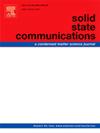Engineering microneedle morphology in MgCo2O4 thin films via deposition time control for advanced supercapacitors electrode
IF 2.4
4区 物理与天体物理
Q3 PHYSICS, CONDENSED MATTER
引用次数: 0
Abstract
MgCo2O4 thin films were successfully synthesized on stainless steel substrates using a chemical bath deposition (CBD) technique with varying deposition times of 4, 5, and 6 h to investigate their suitability for supercapacitor applications. Structural analysis via XRD confirmed the formation of the cubic spinel phase, with the 5-h deposited (T5) film exhibiting superior crystallinity and minimal dislocation defects. FTIR spectra validated the spinel structure through characteristic metal–oxygen vibrations, with T5 showing sharper peaks, indicating better structural integrity and surface properties. SEM revealed that the T5 film developed a distinct microneedle-like morphology, enhancing surface area and ion diffusion. Electrochemical studies demonstrated that the T5 electrode achieved high specific capacitances of 652.13 F g−1 at 50 mV s−1 and 433.1 F g−1 at 1 mA cm−2, along with excellent rate capability, low charge transfer resistance, and 78 % capacitance retention over 5000 cycles. These findings emphasize that a 5-h deposition time yields optimal microstructural and electrochemical characteristics, underlining the importance of morphology control in the design of high-performance supercapacitor electrodes.

先进超级电容器电极沉积时间控制下MgCo2O4薄膜微针形貌的工程化研究
采用化学浴沉积(CBD)技术在不锈钢衬底上成功合成了MgCo2O4薄膜,沉积时间分别为4、5和6 h,以研究其在超级电容器中的适用性。XRD结构分析证实了立方尖晶石相的形成,5 h沉积(T5)膜具有优异的结晶度和最小的位错缺陷。FTIR光谱通过特征金属氧振动验证了尖晶石结构,T5显示出更清晰的峰,表明结构完整性和表面性能更好。扫描电镜显示,T5薄膜呈现明显的微针状形貌,增强了表面面积和离子扩散。电化学研究表明,T5电极在50 mV s−1和1 mA cm−2下的比电容分别达到652.13 F g−1和433.1 F g−1,具有优异的倍率能力、低电荷转移电阻和超过5000次循环78%的电容保持率。这些发现强调了5小时的沉积时间可以产生最佳的微观结构和电化学特性,强调了形貌控制在高性能超级电容器电极设计中的重要性。
本文章由计算机程序翻译,如有差异,请以英文原文为准。
求助全文
约1分钟内获得全文
求助全文
来源期刊

Solid State Communications
物理-物理:凝聚态物理
CiteScore
3.40
自引率
4.80%
发文量
287
审稿时长
51 days
期刊介绍:
Solid State Communications is an international medium for the publication of short communications and original research articles on significant developments in condensed matter science, giving scientists immediate access to important, recently completed work. The journal publishes original experimental and theoretical research on the physical and chemical properties of solids and other condensed systems and also on their preparation. The submission of manuscripts reporting research on the basic physics of materials science and devices, as well as of state-of-the-art microstructures and nanostructures, is encouraged.
A coherent quantitative treatment emphasizing new physics is expected rather than a simple accumulation of experimental data. Consistent with these aims, the short communications should be kept concise and short, usually not longer than six printed pages. The number of figures and tables should also be kept to a minimum. Solid State Communications now also welcomes original research articles without length restrictions.
The Fast-Track section of Solid State Communications is the venue for very rapid publication of short communications on significant developments in condensed matter science. The goal is to offer the broad condensed matter community quick and immediate access to publish recently completed papers in research areas that are rapidly evolving and in which there are developments with great potential impact.
 求助内容:
求助内容: 应助结果提醒方式:
应助结果提醒方式:


